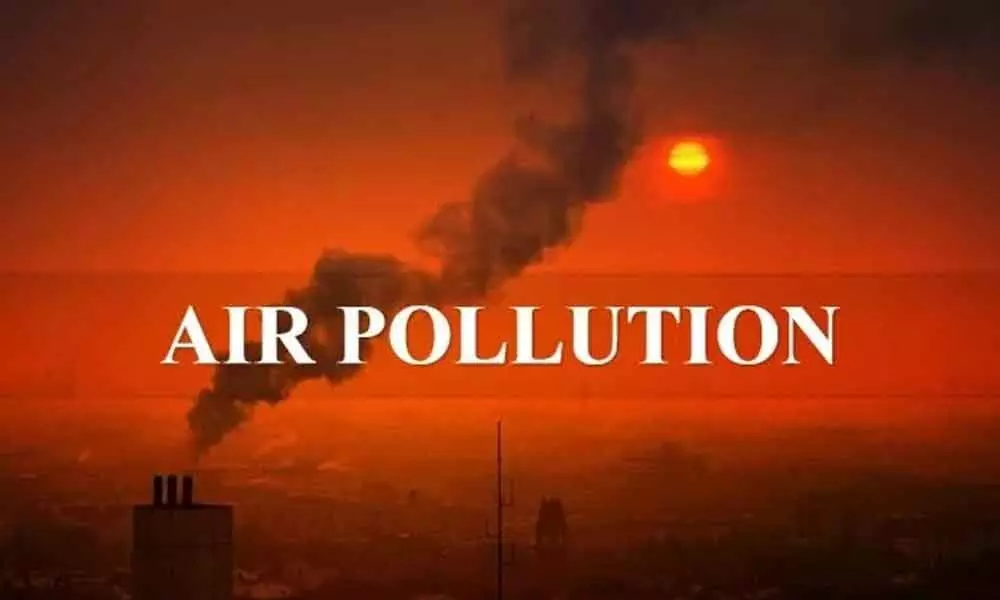Live
- They always want me to win, and now I feel lucky to have been offered a story like ‘Zebra’: Satyadev Kancharana
- ‘Democracy first, humanity first’: PM Modi in Guyana's parliament on two countries' similarities
- PKL Season 11: Telugu Titans register third straight win to top standings
- Is Pollution Contributing to Your COPD?
- NASA Unveils Underwater Robots for Exploring Jupiter's Moons
- Additional Central forces arrive in violence-hit Manipur
- AR Rahman and Saira Banu’s Divorce: Legal Insights into Common Issues in Bollywood Marriages
- 82.7 pc work completed in HPCL Rajasthan Refinery area: official
- Curfew relaxation extended in 5 Manipur districts on Friday
- Tab scam prompts Bengal govt to adopt caution over fund disbursement
Just In
Air pollution in TS worrisome, says study


Exposure to air pollution may lead to higher risk of developing cardiovascular diseases such as stroke or heart attack, according to a study conducted in Hyderabad.
Exposure to air pollution may lead to higher risk of developing cardiovascular diseases such as stroke or heart attack, according to a study conducted in Hyderabad.
The study, published in the International Journal of Epidemiology, was part of The Cardiovascular Health effects of Air pollution in Telangana, India (CHAI) project which aims to analyse the association between particulate matter levels in the air and cardiovascular risk, and is the first to establish this link in a low-middle income country's population.
According to the study, the level of exposure to ambient and household air pollution, is related to carotid intima-media thickness (CIMT).
CIMT is the width of the inner two layers of the carotid artery that supplies blood to the brain, face, and neck and is a marker for atherosclerosis - a plaque forming disease of the arteries affecting more than 10 million Indians each year, the researchers, including those from Sri Ramachandra University (SRU) in Chennai, Tamil Nadu, said.
As part of the study, an international team of researchers measured the CIMT of 3,372 participants from a peri-urban region of Hyderabad and estimated their exposure to air pollution.
The air pollution exposure was calculated using an algorithm called land use regression (LUR), which the researchers said is frequently used to predict the amount of fine particles suspended in air (diameter under 2.5 µm) in high-income countries.
The participants also provided information on the type of cooking fuel they used, the study noted. The results of the study indicate that a high annual exposure to PM2.5 fine particles is linked to a higher CIMT, particularly in men above 40 years of age, or those with cardiometabolic risk factors.
The researchers said that nearly 60 per cent of the participants used biomass cooking fuel. "People using biomass fuel for cooking had a higher CIMT, particularly women who cooked in unventilated spaces," said Otavio Ranzani, lead scientist of the study from Barcelona Institute of Global Health (ISGlobal) in Spain.
"Women had a higher CIMT than men, which could be due to the fact that they spend more time in the kitchen, breathing air polluted by biomass fuel," he said. The study noted that the annual average exposure to PM2.5 among the participants was 32.7 microgram per cubic metre, which is far above the WHO recommended maximum level of 10 microgram per cubic metre.
"This study is relevant for countries which, like India, are experiencing a rapid epidemiological transition and a sharp increase in the prevalence of hypertension, diabetes and obesity. In addition, the country is affected by high levels of air pollution, both ambient and indoors," said Cathryn Tonne, study co-author from ISGlobal.
The researchers cautioned that the study cannot be generalised to all urban and peri-urban centres in India since the pollution levels and the prevalence of metabolic disorders varied across the country.
"We observed a lower level of annual ambient PM2.5 than occurs in cities in Northern India (e.g. New Delhi), and lower prevalence of central obesity and metabolic syndrome than expected for urban populations in India."
"Therefore, generalisability of our estimates to urban India may be somewhat limited, and further studies are needed to better represent other populations in LMICs," the researchers wrote in the study.
Tonne said there is a need to perform more studies on air pollution in other low- and middle-income countries, since the conclusions may differ considerably from those conducted in high income countries as there are differences in population characteristics and air pollution levels and sources.

© 2024 Hyderabad Media House Limited/The Hans India. All rights reserved. Powered by hocalwire.com






